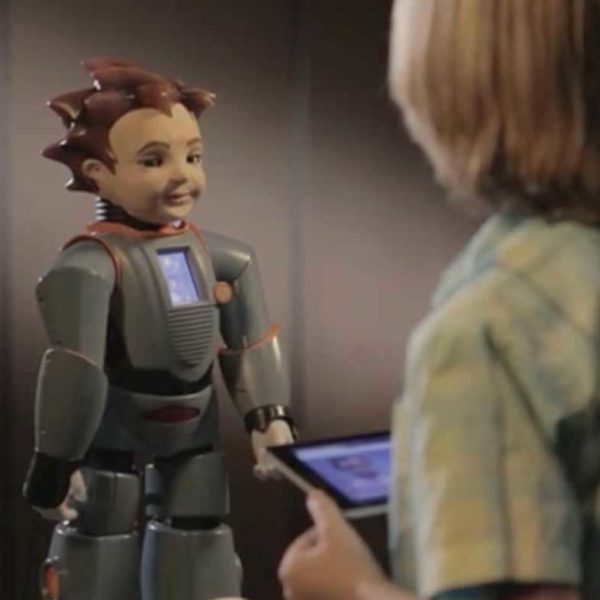These four innovations in special-education technology were on display at a special event during the annual ISTE conference in Atlanta

A software program that can boost the memory and attention of students with disabilities, called the “most innovative medical advancement of 2012” by the National Institutes of Health, was among four special-education technologies highlighted during an event at the 2014 ISTE conference in Atlanta.
ISTE stands for the International Society for Technology in Education, and its annual conference is the largest ed-tech trade show in North America.
More than 16,000 educators and administrators gathered in Atlanta for this year’s conference, including a few dozen special-education teachers and administrators who attended a special event on June 30, hosted by the public relations firm C. Blohm & Associates.
For this event, C. Blohm partnered with the Inclusive Learning Network (a special-education focus group affiliated with ISTE), Arc Capital Development, and the Atlanta Braves to showcase four innovations in special-education technology—including a robot with very natural-looking facial expressions that is helping students on the autism spectrum learn social cues.
Also shown during the event was a “cognitive cross-training program” from a company called C8 Sciences, developed by Dr. Bruce Wexler, a neuroscientist at the Yale School of Medicine.
Built on the theory of neuroplasticity—the idea that our brains can change as a result of experience—the program combines computer games and physical exercises to help students with ADHD or other learning disabilities develop eight key areas of “executive functioning” that form the basis for all learning.
The human brain is like a muscle, said Myron Pincomb, an investor in C8 Sciences who was on hand to discuss the program. “If you’re very specific in how you exercise it,” he said, “you’re going to get specific results.”
C8’s ACTIVATE program is being used in some 130 school districts, Pincomb said, including Virginia’s Fairfax County Schools—where about 3,000 students have seen measurable gains in their working memory, sustained attention, and impulse control, while also reducing the time it takes to process information.
(Next page: Three more innovations in special-education technology)
RoboKind has been previewing its robotics-based “autism intervention tool” for about a year, and during the June 30 ISTE event, Director of School Sales and Marketing Claude Bove made a big announcement: The technology is now ready to deploy in schools.
“We are at a point where we are shipping 100 robots this month,” he said. “We’re ready to go tomorrow.”
Called Robots4Autism, the product combines a two-foot-tall humanoid robot called Milo—whose facial expressions can convey a wide range of emotions—with a research-based curriculum to teach students with autism how to recognize social cues.
Using a robot with very natural-looking facial expressions lets children interact and learn social skills in a less stressful situation, before practicing these skills with real people, said Pamela Rollins, an associate professor and speech pathologist for the University of Texas at Dallas, in a video clip.
Once students have been using the curriculum for about a year, “it is our hope they’ll be able to lead more fulfilling lives [and] participate in more activities with their peers and family members,” said Rollins, who co-developed the curriculum.
Bove said his company is looking for 100 demonstration sites for the technology; participating schools would receive matching grants to cover half the cost of the program. Educators who are interested can contact RoboKind for more information.
With their interactive touch screens, tablet computers have become popular tools in special-education classrooms, and David Pasqua of TabPilot discussed his company’s solutions for helping both general and special-education teachers manage students’ tablet use.
For more news from ISTE 2014, see:
Fifty from ISTE: 50 new ed-tech services
“Those of you who use tablets in your classrooms, how well do you manage them to keep the students focused on what they’re supposed to do?” he asked. That’s what TabPilot helps with, he noted—it “puts you, the teacher, in control.”
TabPilot’s software allows teachers to launch apps or websites on students’ Android devices; lock students’ screens, so they see “only the things you want them to see”; and monitor students’ screens in real time. A secure web browser omits the navigation bar, keeping kids on the web page assigned and turning it into a “dedicated learning activity,” Pasqua said.
What’s more, a simple management console lets teachers easily set up customized tablets for each student, helping to personalize instruction—and then quickly reset the devices for others to use.
TabPilot also makes its own tablet for education, called the Breea—and the company gave away a Breea to one lucky event participant.
Glen Dobbs, the founder of ProxTalker, had a very personal inspiration for developing special-education solutions: His nine-year-old son has severe autism.
Dobbs’ company takes a “non-tablet” approach to augmented communication, he said, for children who need a more “tactile” experience. Its PROXTALKER device uses RFID technology to retrieve vocabulary stored on sound tags to produce spoken words, and the company also makes a six-dot Braille labeler.
“We … have a loan program, and we are covered by Medicaid in some states,” Dobbs said of the technology.
Follow Editorial Director Dennis Pierce on Twitter: @eSN_Dennis.
- Can technology help schools prevent AI-based cheating? - April 14, 2023
- How to ensure digital equity in online testing - July 6, 2022
- ‘Digital skills gap’ threatens innovation - May 30, 2022

